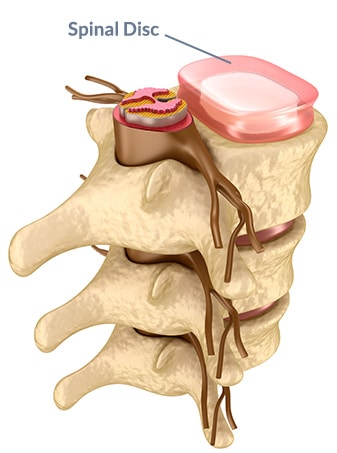Degenerative Disc Disease Treatment in San Antonio, Texas
The spinal discs are sometimes referred to as the shock absorbers of our spine. They cushion the stress placed on our spine by our bodies and activity. Slowly over time, these cushions begin to wear out and become thinner, which can lead to back pain and a spinal condition known as degenerative disc disease. Degenerative disc disease happens very slowly over many years of your life. Because the condition progresses so slowly, the body adapts to the changes and most people go years without having any pain or symptoms at all.
What is a spinal disc made of?
The disc consists of two parts:

Nucleus
The center, referred to as the nucleus pulposis, is comprised of a gelatinous matrix similar to jelly.
Matrix
The matrix is made of mostly water. The outer covering that keeps the nucleus intact is called the annulus fibrosis, which is made of crisscrossing fibers.
The disc itself consists of about 88% water, but as we age, the disc begins to lose water which flattens and thins the disc. This is known as disc degeneration.
Request an Appointment
Please fill out the information below & someone from our team will contact you to confirm your visit.
What causes degenerative disc disease?
Time and injury. Time is inevitable and disc degeneration occurs more rapidly after disc injuries like herniated discs. As the disc thins, more stress is placed on the joints behind the disc. Consequently, the disc space narrowing reduces the size of the opening where the nerve roots exit the spinal canal.
The reduction in the size of the “nerve hole” creates irritation and causes an inflammatory process. The result is a myriad of effects that include inflammation of the nerve, inflammation of the surrounding tissue, muscle spasms, and pain. It is also possible to develop pain from the degenerative disc known as discogenic back pain. Discogenic back pain can be one of the most difficult types of back pain to treat unless you have a method to treat the disc itself.
At Texas Spine Clinic, we use the DRX 9000 spinal decompression to decompress the degenerative disc. By stretching the disc fibers, a healing response is triggered in the tissue known as a fibroblastic response. This healing helps to tighten the disc fibers. Also, stretching the disc reduces disc pressure and allows for fluid exchange and better hydration of the disc. In more challenging conditions, pain management procedures like epidural steroid injections can provide relief by controlling the inflammation.
What are the symptoms of disc degeneration?
Depending on the severity of the herniation or bulging, a patient may experience a variety of symptoms, including:
- Localized back pain
- Leg pain or burning
- Numbness
- Tingling
- Muscular weakness
Suffering from degenerative disc disease?
Find out if our team of specialists can help you get relief from your pain today. Call 210-741-9166 and schedule an appointment to see which treatment is right for you.
